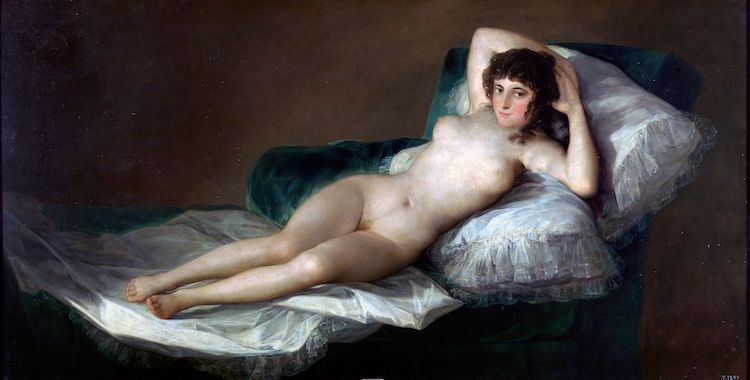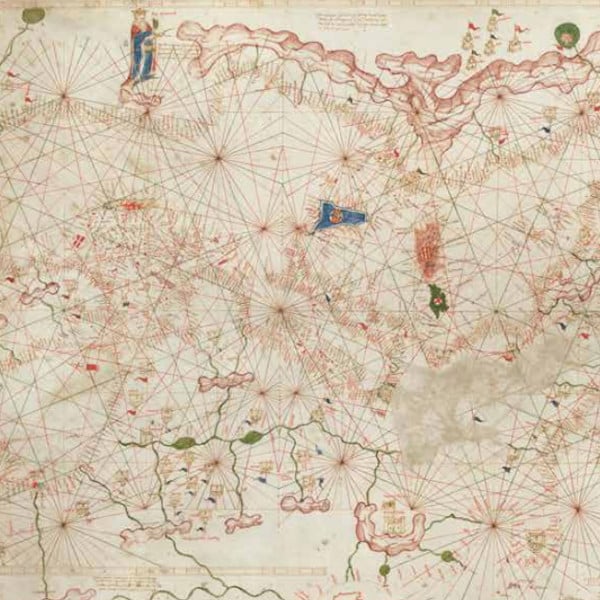
Self-Portrait Before the Easel, 1785 (Photo: Wikimedia Commons Public Domain)
Today, Francisco Goya is widely considered to be one of art history's most influential figures. Associated with Romanticism, a movement born in the late 18th century, Goya is simultaneously celebrated as one of the last Old Masters and as a forefather of modern art. While these roles may seem incongruent, a look at his most well-known works of art can help make the connection.
Here, we present and explore six of Goya's most famous paintings. Featuring royalty, nudity, war, and even the occult, this selection of masterpieces illustrates the artist's unusual, and, most importantly, unprecedented approach to painting.
Take a look at six of Spanish master Francisco Goya's most well-known works of art.
The Nude Maja, 1797-1800

The Nude Maja, 1797-1800 (Photo: Wikimedia Commons Public Domain)
In 1797, Goya began working on one of his most controversial paintings: The Nude Maja. As its straightforward title suggests, this piece depicts a maja, a name given to a person from Madrid's lower classes, posing while completely nude. While plenty of artists had portrayed the nude female form in the history of art, the context of this depiction made it particularly unusual.
Void of mythological, allegorical, or historical undertones, The Nude Maja stars a contemporary figure gratutiously shown without clothing. While the piece's exact origins are unknown, historians believe it was commissioned by Manuel de Godoy, the First Secretary of State of Spain, to join his private collection of nude paintings.
The Nude Maja was confiscated during the Spanish Inquisition. Since then, it has hung in both the Royal Academy of Fine Arts of San Fernando and the Prado, where—along with a companion painting—it remains today.
The Clothed Maja, 1798-1805

The Clothed Maja, 1798-1805 (Photo: Wikimedia Commons Public Domain)
Five years after finishing The Nude Maja, Goya completed The Clothed Maja, its pendant painting. This work of art depicts the same subject, composition, and pose. However, in this case, the maja is dressed.
The obvious addition of clothing is not the only difference between the two paintings. In The Clothed Maja, the figure and her bed take up more space in the composition. Though a seemingly minor change, it may have been intentional, as this more in-your-face arrangement implies a sense of confidence that contrasts the timid nature of the nude subject.
Charles IV of Spain and His Family, 1800-1801

Charles IV of Spain and His Family, 1800-1801 (Photo: Wikimedia Commons Public Domain)
In 1799, at the age of 53, Goya became Primer Pintor de Cámara, the most prestigious position for a Spanish court painter. Building on the approach of Diego Velázquez, a former Primer Pintor de Cámara, Goya was renowned for his ability to skillfully capture the likeness of his subjects.
While Velázquez sought to paint his subjects in a light that was both realistic and positive, however, Goya was unforgiving in his assessments. In his court paintings, like Charles IV of Spain and His Family, he rendered the figures' flaws in detail, materializing as a stiff and staged look at an over-the-top family.
Though this approach to painting the royal family sets Goya apart from Velázquez, it is clear that he still looked to the artist for inspiration. Much like in Las Meninas, Velázquez's most well-known royal painting, Charles IV of Spain and His Family includes a self-portrait of the artist sitting at his easel.
The Third of May 1808, 1814

The Third of May 1808, 1814 (Photo: Wikimedia Commons Public Domain)
Goya saw success as a court painter. However, what is widely considered to be his most famous painting is not related to royalty; in fact, it is radically political. In The Third of May 1808, Goya pays tribute to the Spaniards who revolted against French armies during one of the Napoleonic Wars.
Specifically, the painting portrays Napoleon's army clashing with Spanish civilians following an uprising. Dramatically lit, full of action, and packed with emotion, it captures the exact moment that the French firing squad slaughtered a group of helpless captives—all of whom were fighting to save their leaders and country from Napoleon's conquest.
Because of Goya's revolutionary and dark approach to depicting war, The Third of May 1808 is among one of modern art's most important pieces. Famed British art historian and museum director Kenneth Clark even deemed it “the first great picture which can be called revolutionary in every sense of the word, in style, in subject, and in intention.”
Saturn Devouring His Son, 1819-1823

Saturn Devouring His Son, c. 1819-1823 (Photo: Wikimedia Commons Public Domain)
For the remainder of his life, Goya would continue to channel the despair evident in The Third of May 1808. Between 1819 and 1823, Goya created his Black Paintings, a collection of 14 particularly haunting pieces. Dark in both subject matter and color palette, these works were crafted to adorn the walls of the aging and ailing artist’s Madrid home—by this point, he had suffered two serious sicknesses and, as a result, also dealt with anxiety.
Among the most famous of these frightening works is Saturn Devouring His Son, a grisly oil painting of a father feasting on his child. In Roman mythology, Saturn was the leader of the Titans who had toppled his father, Caelus, in a bid to become ruler of the universe. After successfully overthrowing Caelus, he feared that his own descendants would do the same. To prevent this fate, he killed and consumed each child shortly after birth—though Goya took artistic license and depicted Saturn's son as an adult.
In the 1870s—roughly 50 years after the artist's death—the wallpaper on which Goya rendered his Black Paintings was removed from the walls and attached to canvas. In 1881, they were donated to the Spanish state, and, today, they are a highlight of Madrid's Prado Museum.
Witches' Sabbath (The Great He-Goat), 1821

Witches' Sabbath (The Great He-Goat), 1821 (Photo: Wikimedia Commons Public Domain)
Saturn Devouring His Son is not the only Black Painting to have gained popularity. Another world-famous work from this collection is Witches' Sabbath (The Great He-Goat). This haunting piece stars Satan—rendered by Goya as a large, looming silhouette of an anthropomorphic goat—presiding over a coven of witches.
Like his other Black Paintings, the dark themes present in this painting are believed to have been inspired by Goya's deteriorating mental and physical state. Still, even before his suffering, Goya had a preference for a somber palette. “In art, there is no need for color,” he wrote. “I see only light and shade.”
Unfortunately, when Witches' Sabbath (The Great He-Goat) was “hacked off” the walls of Goya's former home, nearly five-feet of it was lost. However, at over 14 feet wide, this piece remains one of Goya's most celebrated (and spooky) large-scale paintings.
Related Articles:
7 of Art History’s Most Horrifying Masterpieces
Why Post-Impressionist Painter Paul Cézanne Is Known as the “Father of Modern Art”
The Life and Work of J.M.W. Turner: One of the Most Influential Figures of Modern Art






















































































